Aiwei Liu
Mark Your LLM: Detecting the Misuse of Open-Source Large Language Models via Watermarking
Mar 06, 2025Abstract:As open-source large language models (LLMs) like Llama3 become more capable, it is crucial to develop watermarking techniques to detect their potential misuse. Existing watermarking methods either add watermarks during LLM inference, which is unsuitable for open-source LLMs, or primarily target classification LLMs rather than recent generative LLMs. Adapting these watermarks to open-source LLMs for misuse detection remains an open challenge. This work defines two misuse scenarios for open-source LLMs: intellectual property (IP) violation and LLM Usage Violation. Then, we explore the application of inference-time watermark distillation and backdoor watermarking in these contexts. We propose comprehensive evaluation methods to assess the impact of various real-world further fine-tuning scenarios on watermarks and the effect of these watermarks on LLM performance. Our experiments reveal that backdoor watermarking could effectively detect IP Violation, while inference-time watermark distillation is applicable in both scenarios but less robust to further fine-tuning and has a more significant impact on LLM performance compared to backdoor watermarking. Exploring more advanced watermarking methods for open-source LLMs to detect their misuse should be an important future direction.
Semi-Supervised In-Context Learning: A Baseline Study
Mar 04, 2025Abstract:Most existing work in data selection for In-Context Learning (ICL) has focused on constructing demonstrations from ground truth annotations, with limited attention given to selecting reliable self-generated annotations. In this work, we propose a three-step semi-supervised ICL framework: annotation generation, demonstration selection, and semi-supervised inference. Our baseline, Naive-SemiICL, which prompts select high-confidence self-generated demonstrations for ICL prompting, outperforms a 16-shot baseline by an average of 9.94% across 16 datasets. We further introduce IterPSD, an annotation approach that refines pseudo-demonstrations iteratively, achieving up to 6.8% additional gains in classification tasks. Lastly, we reveal a scaling law for semi-supervised ICL, where models achieve optimal performance with over 1,000 demonstrations.
TabGen-ICL: Residual-Aware In-Context Example Selection for Tabular Data Generation
Feb 23, 2025Abstract:Large Language models (LLMs) have achieved encouraging results in tabular data generation. However, existing approaches require fine-tuning, which is computationally expensive. This paper explores an alternative: prompting a fixed LLM with in-context examples. We observe that using randomly selected in-context examples hampers the LLM's performance, resulting in sub-optimal generation quality. To address this, we propose a novel in-context learning framework: TabGen-ICL, to enhance the in-context learning ability of LLMs for tabular data generation. TabGen-ICL operates iteratively, retrieving a subset of real samples that represent the residual between currently generated samples and true data distributions. This approach serves two purposes: locally, it provides more effective in-context learning examples for the LLM in each iteration; globally, it progressively narrows the gap between generated and real data. Extensive experiments on five real-world tabular datasets demonstrate that TabGen-ICL significantly outperforms the random selection strategy. Specifically, it reduces the error rate by a margin of $3.5\%-42.2\%$ on fidelity metrics. We demonstrate for the first time that prompting a fixed LLM can yield high-quality synthetic tabular data. The code is provided in the \href{https://github.com/fangliancheng/TabGEN-ICL}{link}.
Can LLM Watermarks Robustly Prevent Unauthorized Knowledge Distillation?
Feb 17, 2025Abstract:The radioactive nature of Large Language Model (LLM) watermarking enables the detection of watermarks inherited by student models when trained on the outputs of watermarked teacher models, making it a promising tool for preventing unauthorized knowledge distillation. However, the robustness of watermark radioactivity against adversarial actors remains largely unexplored. In this paper, we investigate whether student models can acquire the capabilities of teacher models through knowledge distillation while avoiding watermark inheritance. We propose two categories of watermark removal approaches: pre-distillation removal through untargeted and targeted training data paraphrasing (UP and TP), and post-distillation removal through inference-time watermark neutralization (WN). Extensive experiments across multiple model pairs, watermarking schemes and hyper-parameter settings demonstrate that both TP and WN thoroughly eliminate inherited watermarks, with WN achieving this while maintaining knowledge transfer efficiency and low computational overhead. Given the ongoing deployment of watermarking techniques in production LLMs, these findings emphasize the urgent need for more robust defense strategies. Our code is available at https://github.com/THU-BPM/Watermark-Radioactivity-Attack.
Cold-Start Recommendation towards the Era of Large Language Models (LLMs): A Comprehensive Survey and Roadmap
Jan 03, 2025Abstract:Cold-start problem is one of the long-standing challenges in recommender systems, focusing on accurately modeling new or interaction-limited users or items to provide better recommendations. Due to the diversification of internet platforms and the exponential growth of users and items, the importance of cold-start recommendation (CSR) is becoming increasingly evident. At the same time, large language models (LLMs) have achieved tremendous success and possess strong capabilities in modeling user and item information, providing new potential for cold-start recommendations. However, the research community on CSR still lacks a comprehensive review and reflection in this field. Based on this, in this paper, we stand in the context of the era of large language models and provide a comprehensive review and discussion on the roadmap, related literature, and future directions of CSR. Specifically, we have conducted an exploration of the development path of how existing CSR utilizes information, from content features, graph relations, and domain information, to the world knowledge possessed by large language models, aiming to provide new insights for both the research and industrial communities on CSR. Related resources of cold-start recommendations are collected and continuously updated for the community in https://github.com/YuanchenBei/Awesome-Cold-Start-Recommendation.
Exploring Response Uncertainty in MLLMs: An Empirical Evaluation under Misleading Scenarios
Nov 05, 2024



Abstract:Ensuring that Multimodal Large Language Models (MLLMs) maintain consistency in their responses is essential for developing trustworthy multimodal intelligence. However, existing benchmarks include many samples where all MLLMs \textit{exhibit high response uncertainty when encountering misleading information}, requiring even 5-15 response attempts per sample to effectively assess uncertainty. Therefore, we propose a two-stage pipeline: first, we collect MLLMs' responses without misleading information, and then gather misleading ones via specific misleading instructions. By calculating the misleading rate, and capturing both correct-to-incorrect and incorrect-to-correct shifts between the two sets of responses, we can effectively metric the model's response uncertainty. Eventually, we establish a \textbf{\underline{M}}ultimodal \textbf{\underline{U}}ncertainty \textbf{\underline{B}}enchmark (\textbf{MUB}) that employs both explicit and implicit misleading instructions to comprehensively assess the vulnerability of MLLMs across diverse domains. Our experiments reveal that all open-source and close-source MLLMs are highly susceptible to misleading instructions, with an average misleading rate exceeding 86\%. To enhance the robustness of MLLMs, we further fine-tune all open-source MLLMs by incorporating explicit and implicit misleading data, which demonstrates a significant reduction in misleading rates. Our code is available at: \href{https://github.com/Yunkai696/MUB}{https://github.com/Yunkai696/MUB}
Less is More: Extreme Gradient Boost Rank-1 Adaption for Efficient Finetuning of LLMs
Oct 25, 2024Abstract:Fine-tuning Large Language Models (LLMs) has become a crucial technique for adapting pre-trained models to downstream tasks. However, the enormous size of LLMs poses significant challenges in terms of computational complexity and resource requirements. Low-Rank Adaptation (LoRA) has emerged as a promising solution. However, there exists a gap between the practical performance of low-rank adaptations and its theoretical optimum. In this work, we propose eXtreme Gradient Boosting LoRA (XGBLoRA), a novel framework that bridges this gap by leveraging the power of ensemble learning. Inspired by gradient boosting, XGBLoRA iteratively learns and merges a sequence of LoRA adaptations to refine model predictions. It achieves better performance than the standard LoRA, while enjoying the computational efficiency of rank-1 adaptations. We provide theoretical analysis to show the convergence and optimality of our approach, and conduct extensive experiments on a range of natural language processing tasks. The results demonstrate that XGBLoRA consistently outperforms standard LoRA and achieves performance comparable to full fine-tuning with significantly fewer trainable parameters. This work advances parameter-efficient fine-tuning for LLMs, and offers a promising solution for adapting LLMs to downstream tasks while optimizing performance and efficiency.
Recent Advances of Multimodal Continual Learning: A Comprehensive Survey
Oct 07, 2024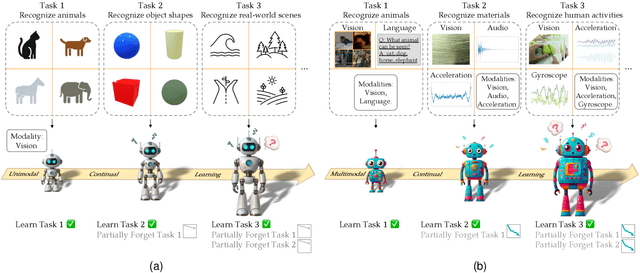
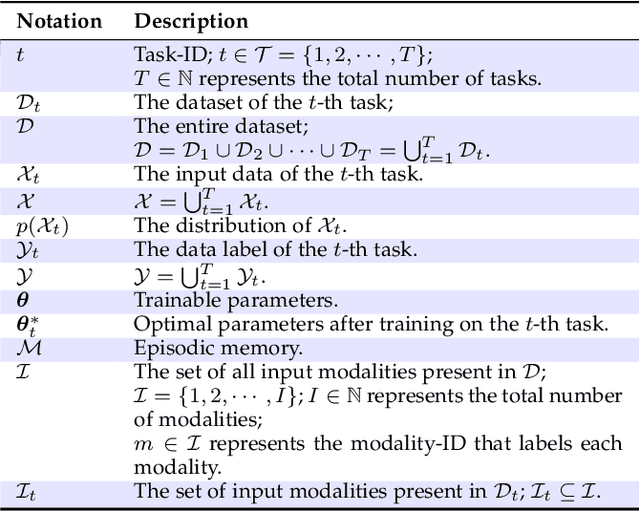
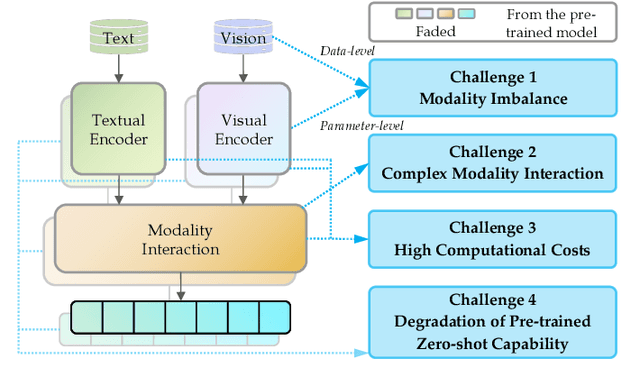
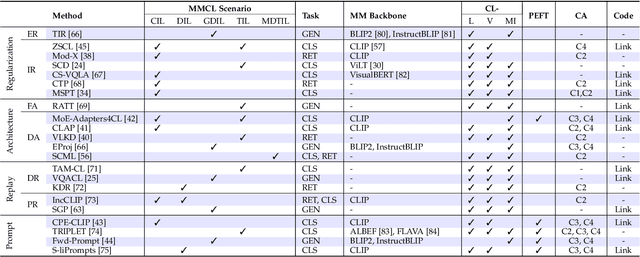
Abstract:Continual learning (CL) aims to empower machine learning models to learn continually from new data, while building upon previously acquired knowledge without forgetting. As machine learning models have evolved from small to large pre-trained architectures, and from supporting unimodal to multimodal data, multimodal continual learning (MMCL) methods have recently emerged. The primary challenge of MMCL is that it goes beyond a simple stacking of unimodal CL methods, as such straightforward approaches often yield unsatisfactory performance. In this work, we present the first comprehensive survey on MMCL. We provide essential background knowledge and MMCL settings, as well as a structured taxonomy of MMCL methods. We categorize existing MMCL methods into four categories, i.e., regularization-based, architecture-based, replay-based, and prompt-based methods, explaining their methodologies and highlighting their key innovations. Additionally, to prompt further research in this field, we summarize open MMCL datasets and benchmarks, and discuss several promising future directions for investigation and development. We have also created a GitHub repository for indexing relevant MMCL papers and open resources available at https://github.com/LucyDYu/Awesome-Multimodal-Continual-Learning.
Mitigating Modality Prior-Induced Hallucinations in Multimodal Large Language Models via Deciphering Attention Causality
Oct 07, 2024



Abstract:Multimodal Large Language Models (MLLMs) have emerged as a central focus in both industry and academia, but often suffer from biases introduced by visual and language priors, which can lead to multimodal hallucination. These biases arise from the visual encoder and the Large Language Model (LLM) backbone, affecting the attention mechanism responsible for aligning multimodal inputs. Existing decoding-based mitigation methods focus on statistical correlations and overlook the causal relationships between attention mechanisms and model output, limiting their effectiveness in addressing these biases. To tackle this issue, we propose a causal inference framework termed CausalMM that applies structural causal modeling to MLLMs, treating modality priors as a confounder between attention mechanisms and output. Specifically, by employing backdoor adjustment and counterfactual reasoning at both the visual and language attention levels, our method mitigates the negative effects of modality priors and enhances the alignment of MLLM's inputs and outputs, with a maximum score improvement of 65.3% on 6 VLind-Bench indicators and 164 points on MME Benchmark compared to conventional methods. Extensive experiments validate the effectiveness of our approach while being a plug-and-play solution. Our code is available at: https://github.com/The-Martyr/CausalMM
TIS-DPO: Token-level Importance Sampling for Direct Preference Optimization With Estimated Weights
Oct 06, 2024

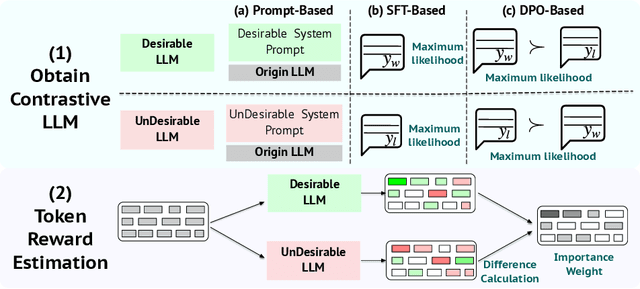
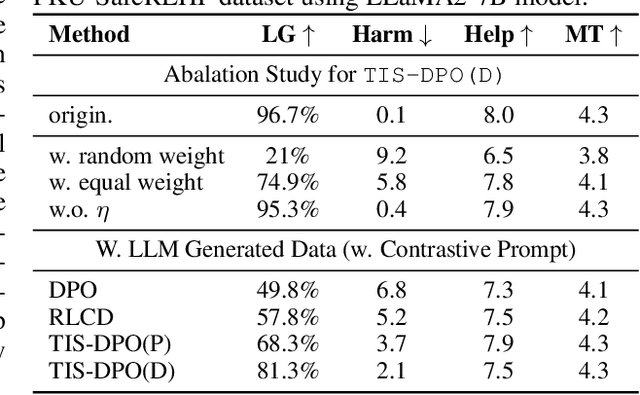
Abstract:Direct Preference Optimization (DPO) has been widely adopted for preference alignment of Large Language Models (LLMs) due to its simplicity and effectiveness. However, DPO is derived as a bandit problem in which the whole response is treated as a single arm, ignoring the importance differences between tokens, which may affect optimization efficiency and make it difficult to achieve optimal results. In this work, we propose that the optimal data for DPO has equal expected rewards for each token in winning and losing responses, as there is no difference in token importance. However, since the optimal dataset is unavailable in practice, we propose using the original dataset for importance sampling to achieve unbiased optimization. Accordingly, we propose a token-level importance sampling DPO objective named TIS-DPO that assigns importance weights to each token based on its reward. Inspired by previous works, we estimate the token importance weights using the difference in prediction probabilities from a pair of contrastive LLMs. We explore three methods to construct these contrastive LLMs: (1) guiding the original LLM with contrastive prompts, (2) training two separate LLMs using winning and losing responses, and (3) performing forward and reverse DPO training with winning and losing responses. Experiments show that TIS-DPO significantly outperforms various baseline methods on harmlessness and helpfulness alignment and summarization tasks. We also visualize the estimated weights, demonstrating their ability to identify key token positions.
 Add to Chrome
Add to Chrome Add to Firefox
Add to Firefox Add to Edge
Add to Edge